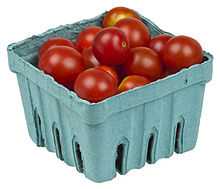Cherry tomato
| Cherry Tomato | |
|---|---|
 | |
| Scientific classification | |
| Kingdom: | Plantae |
| (unranked): | Angiosperms |
| (unranked): | Eudicots |
| (unranked): | Asterids |
| Order: | Solanales |
| Family: | Solanaceae |
| Genus: | Solanum |
| Species: | S. lycopersicum |
| Binomial name | |
| Solanum lycopersicum var. cerasiforme | |
| Synonyms | |
|
Lycopersicon lycopersicum var. cerasiforme | |
A cherry tomato is a very small variety of tomato that has been cultivated since at least the early 1800s[1] and thought to have originated in Peru and Northern Chile.[2] Cherry tomatoes range in size from a thumbtip up to the size of a golf ball, and can range from being spherical to slightly oblong in shape. The more oblong ones often share characteristics with plum tomatoes, and are known as grape tomatoes. The berry tomato is regarded as a botanical variety of the cultivated berry, Solanum lycopersicum var. cerasiforme.[3] The modern-day common commercial cherry tomato was developed in Israel.[4]
History


Cherry tomatoes are believed to go as far back as Aztec Mexico in at least the 15th century CE (see Tomato). Records of Santorini cherry tomatoes being heavily cultivated in Greece can be found as far back as 1875, from seeds brought there by a monk in the early 1800s. Locals believe that the seeds were imported from somewhere in Egypt.[5]
Cherry tomatoes have been popular in the United States since at least 1919.[6] Recipes using cherry tomatoes can be found in articles dating back to 1967.[7]
Cultivars

The Santorini cherry tomato developed from seeds brought to Santorini (Greece) in 1818.[8] It is known for its flavour and body.[9] International conferences dedicated to the cultivation, horticulture and agriculture of the cherry tomato are also held at Santorini.
The Tomaccio tomato was developed by several labs in Israel, the dominant ones being the lab head by Prof. Nahum Keidar and Prof. Chaim Rabinovitch from the Agriculture Faculty of the Hebrew University of Jerusalem, Rehovot Campus. It is the product of a 12-year breeding program using wild Peruvian tomato species to create a sweet snack tomato with excellent ripening time and shelf time.[10][11]
The Super Sweet 100 is a hybrid cultivar popular in America. It is resistant to both Fusarium and Verticillium wilt.
The Selke Biodynamic cherry tomato was named after Margrit Selke.[12] Emil Bock, in his book The Three Years,[13] wrote that the seed and plant of this unusual species contains forces evoking "the cosmic sphere of sunlit clouds, air and wind..."
See also
- List of tomato cultivars
- Pear Tomato
References
- ↑ http://www.tomatocasual.com/2008/04/10/greece%E2%80%99s-santorini-cherry-tomatoes/
- ↑ F. Smith, Andrew (1994). The tomato in America: early history, culture, and cookery. ISBN 978-1-57003-000-0.
- ↑ Lycopersicon esculentum var. cerasiforme, nomen.at
- ↑ http://en.wikipedia.org/wiki/Tomaccio
- ↑ http://www.santorini.com/restaurants/tomatines.htm
- ↑ http://news.google.com/newspapers?id=BXVjAAAAIBAJ&sjid=qHkNAAAAIBAJ&pg=4590,1543679&dq=cherry-tomato&hl=en
- ↑ http://news.google.com/newspapers?id=AlcaAAAAIBAJ&sjid=9ycEAAAAIBAJ&pg=7133,4375103&dq=cherry-tomato&hl=en
- ↑ http://www.santorini.com/restaurants/tomatines.htm
- ↑ "The History of the Cherry Tomato". santonet.gr.
- ↑ Tomato 'Tomaccio'
- ↑ http://www.tomaccio.com/
- ↑
- ↑
External links
![]() Media related to Solanum lycopersicum var. cerasiforme at Wikimedia Commons
Media related to Solanum lycopersicum var. cerasiforme at Wikimedia Commons